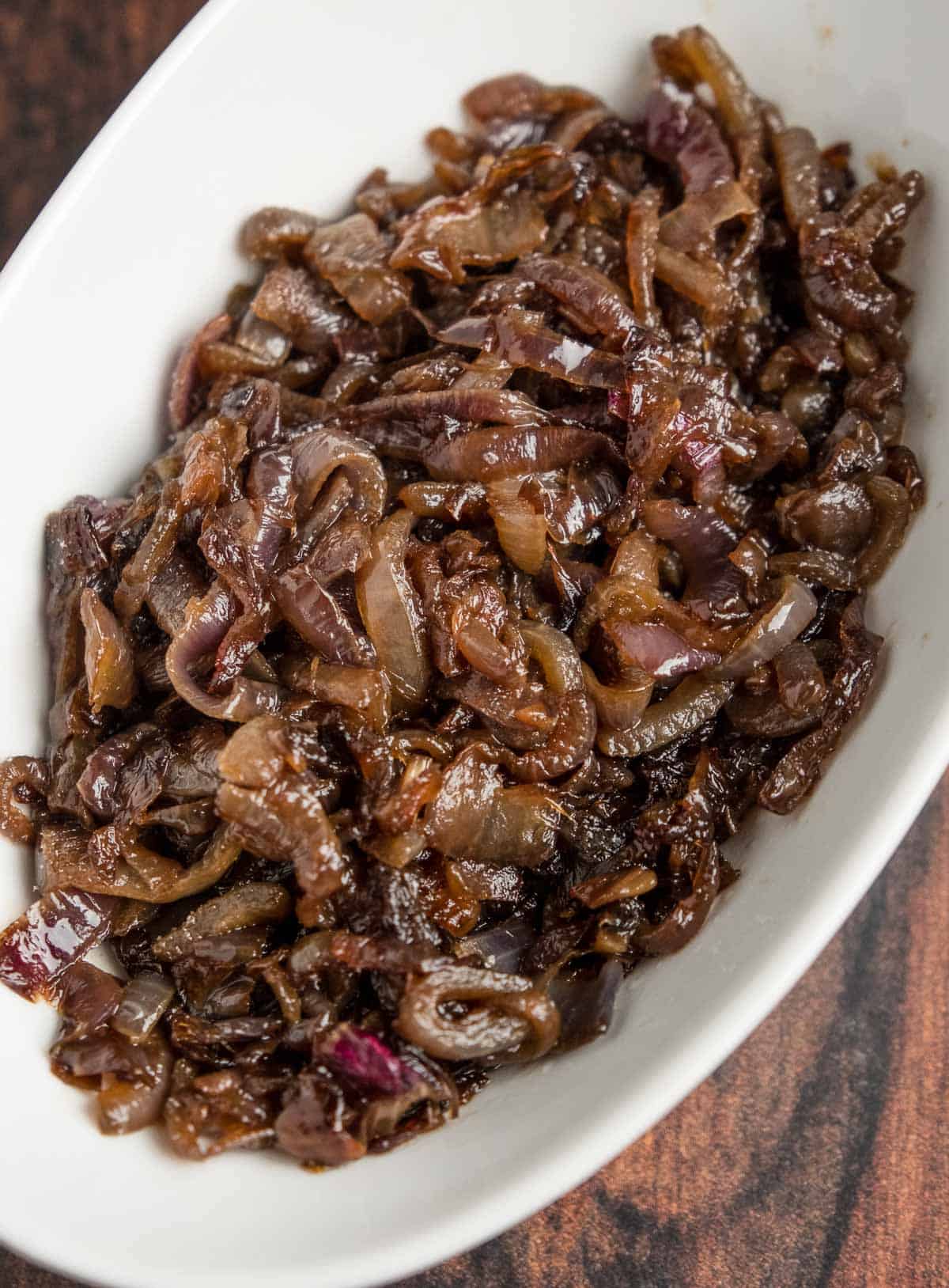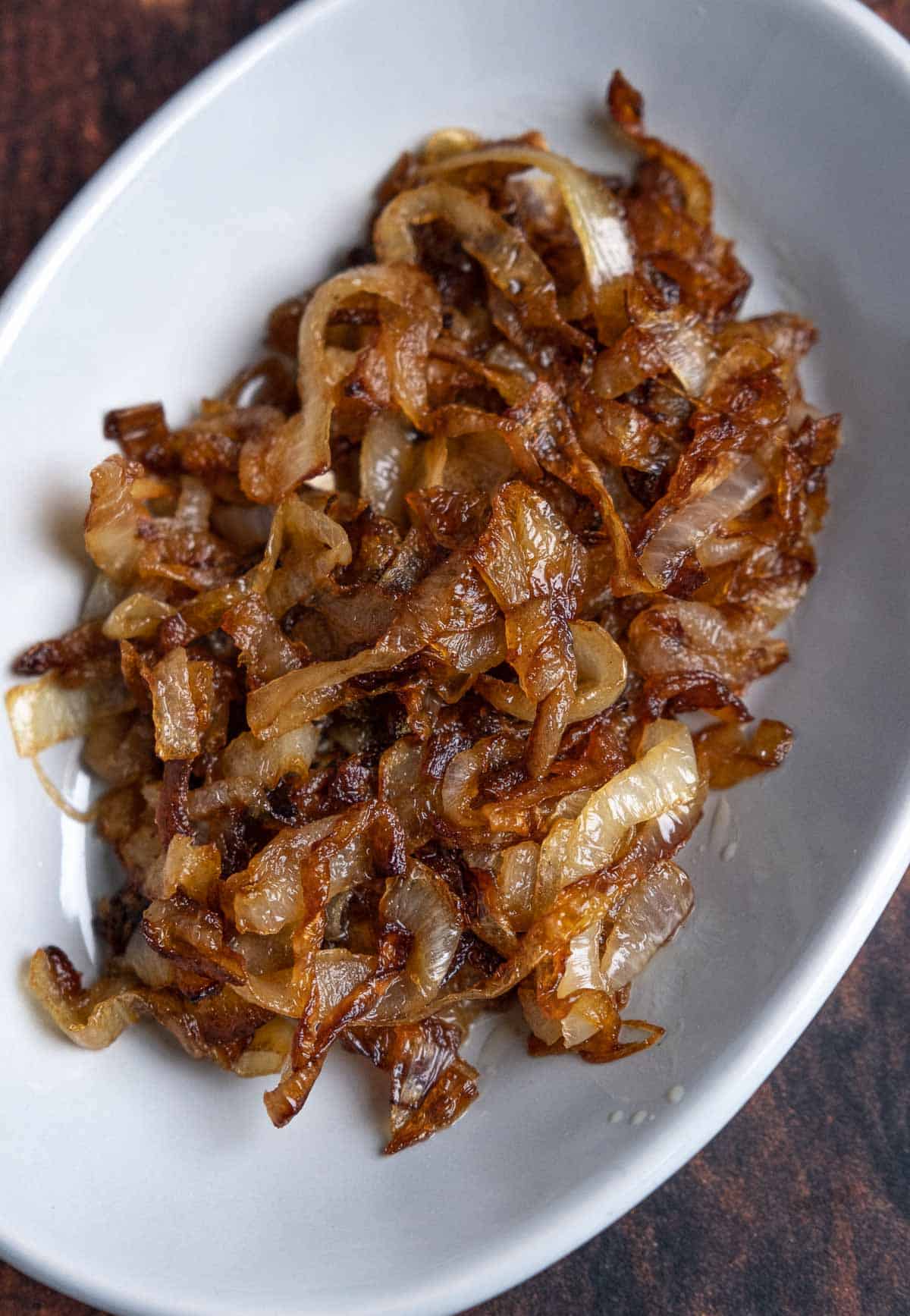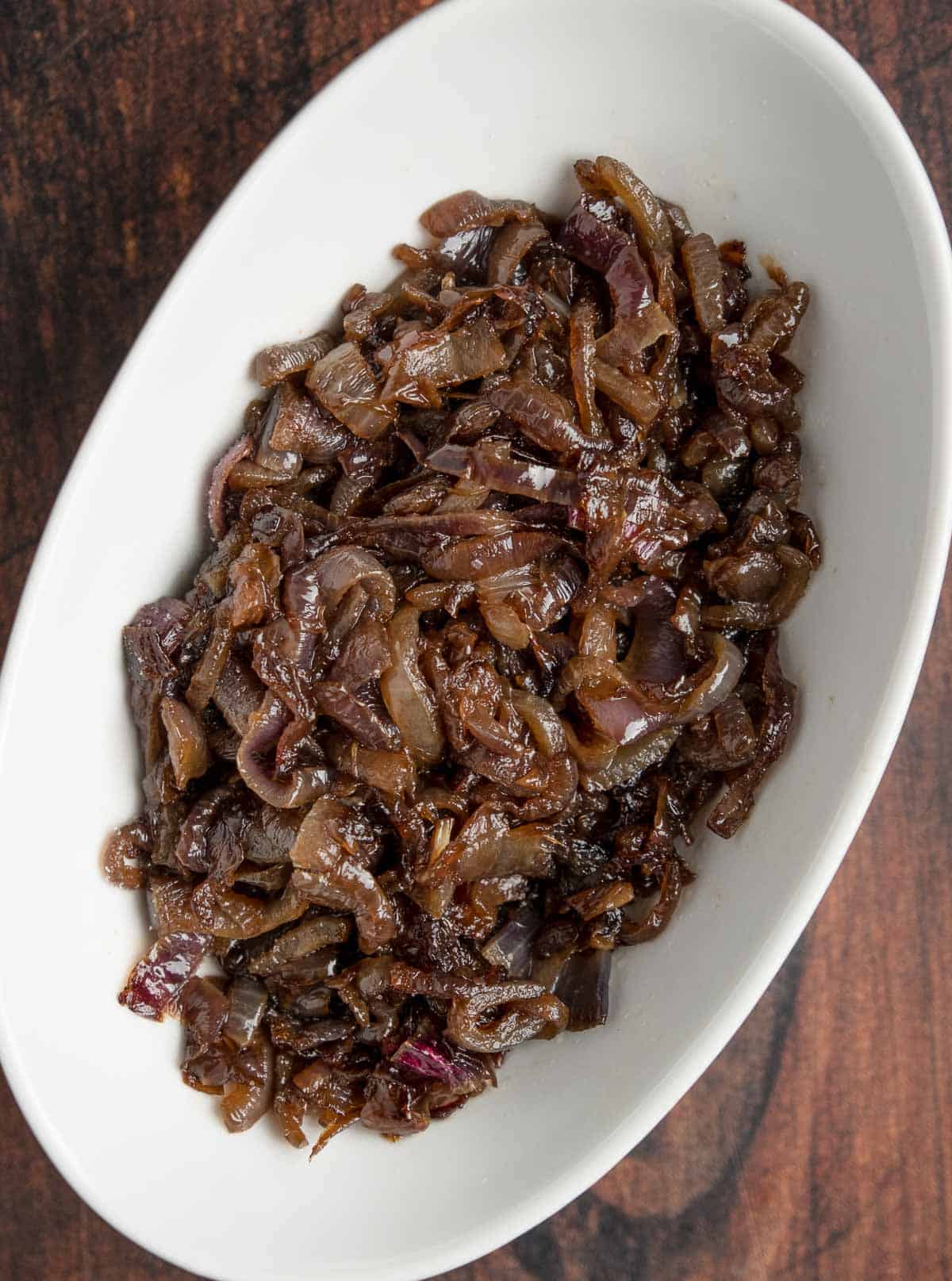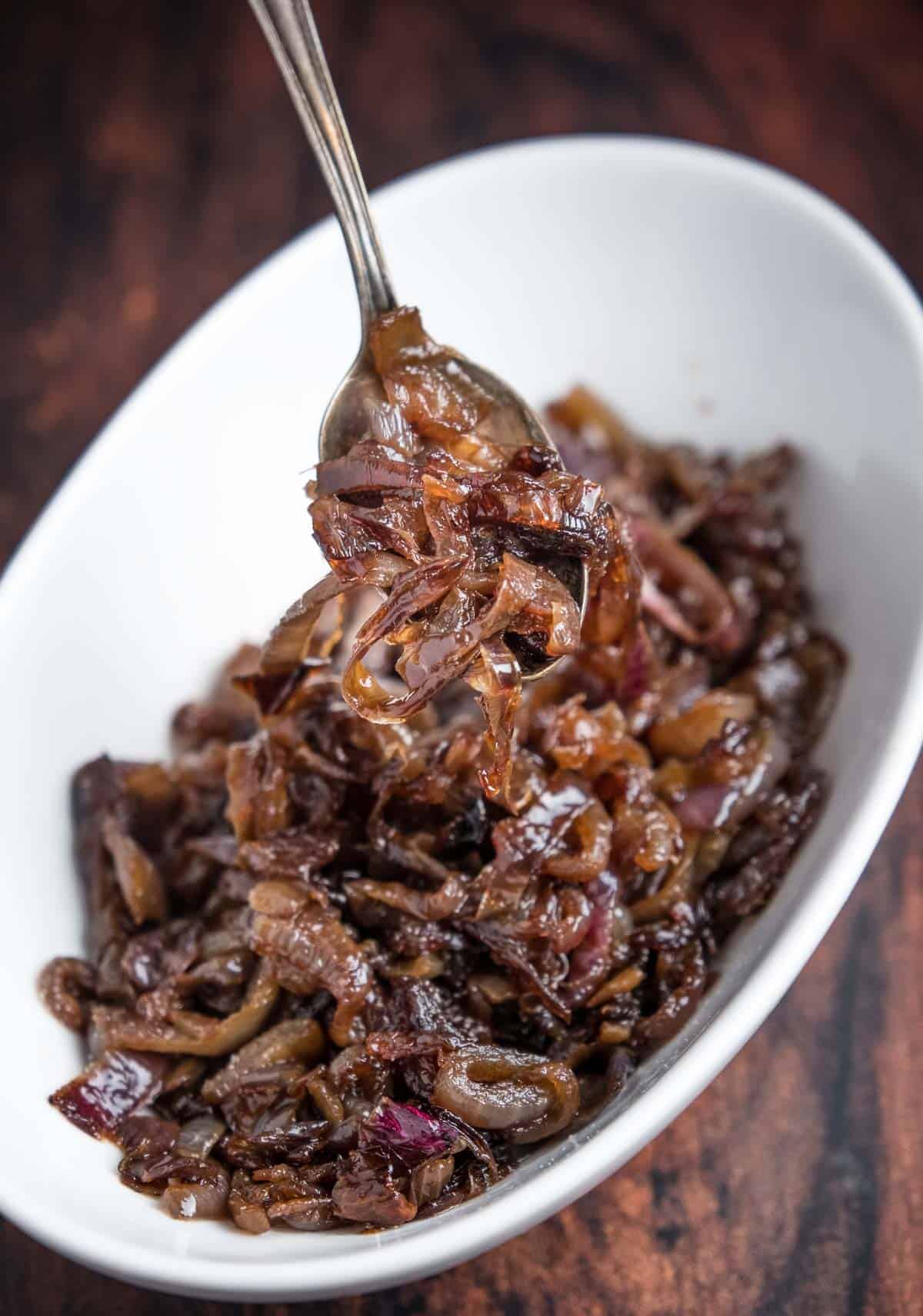This post may contain affiliate links.
Caramelized Onions are among the greatest additions to any recipe, from burgers to pizza. Learn How To Caramelize Onions perfectly every single time using our fail-proof recipe and method. Spoiler alert: this is not a shortcut method.

The key to caramelizing onions is easy: onions + butter and/or olive oil + low heat + time. I’m constantly looking at recipes that call for caramelizing onions, but instruct, “Cook onions 10 minutes, until caramelized,” or have some quick hack.
I also see it frequently with family members or friends who have some obviously not-caramelized onions they’ve prepared. I don’t blame them, I blame the faulty recipes out there they likely followed.
If you fail to sauté the onions long enough, at a low heat, the browning just won’t happen. You may get softened onions, or perhaps fried onions, but not caramelized. Follow these key steps to learn how to properly caramelize onions.
Ingredients + Substitutions
- Onions – You can use any style of onion you wish, and each comes with its flavor profile. But the majority of the time we are going to reach for a red onion. That’s a personal preference. The pungent flavor softens as you caramelize them and gives a rich flavor. My second favorite choice would be a yellow onion. If you can find Walla Walla sweet onions, those are great too.
- Fat – We like to use an equal combination of unsalted butter and extra virgin olive oil. The fats helps the onions slowly reduce and add flavor. We use 1 tablespoon of each per onion. So for every onion we like to caramelize we use 2 tablespoons of fat. It may seem like a lot, but it really helps to keep from burning over the course of the long cook.
- Kosher Salt – We add a touch of salt when the onions are done to enhance the flavor and bring out the natural sweetness of the onion.


Preparation
Grab a good sauté pan that is at least 8 inches for one entire onion. Ideally cast iron or stainless steel skillet work best. The more onions you cook, the bigger the pan you will need.
Cut the onion in half. Remove the outer skin and lay on its side. Cut even slices. Now you are ready to caramelize the onions.
How to Caramelize Onions – Step by Step
- Heat Up Fat: In a large cast iron skillet (or stainless steel pan) over medium heat add butter and olive oil. Once melted drop in your onion slices. Your onions will be heaped in the pan, and that is normal.
- Cook Onions: Stir up the onions to allow the fats to coat them, then allow the onions to sauté for 10 minutes. They should be steaming by this point. Stir, then adjust the heat down if you see any browning happening in the first 10 minutes.
- Stir Over Low Heat: Continue to stir over low heat every 10 minutes, breaking up any brown bits that may start to develop on the pan. Adjust and fine-tune the heat as needed (I tend to lower the heat as they start to cook). As the onions continue to cook, you will see less steam as the water evaporates.
- Finish: In the final 10 minutes, you may see some of your onions finish early, especially the smaller pieces. You can remove them and set them aside in a small bowl as you stir the remaining onions. Add salt and toss together for the remaining time. After about 40-45 minutes total the onions should be fully browned and reduced by almost 2/3rds. Remove from heat and let cool.
Note: If you see too much browning or liquid evaporation, you can add some water (about 1 tablespoon at a time), and then deglaze the pan breaking up some of those brown bits. But I find if you start with enough fat, and cook at a low enough heat, you usually won’t have to do this. Warning, adding too much water will result in soggy onions. We don’t want that.
Top Recipe Tip
The most important tip is time. Be patient and make sure your pan is not too hot so you get that proper caramelization. The more onions you use, the longer it will take to caramelize them all.
- 1 onion will take roughly 30 minutes
- 2 onions will take roughly 45 minutes
- 3 onions will take up to an hour
Making Caramelized Onions Ahead
You can make caramelized onions up to three days in advance. Just store them in an airtight container in your refrigerator.
If you want to reheat them add them to a small saucepan over medium heat with a little bit of butter (1 tablespoon max). Stir until the butter melts and they are warmed. About 4 minutes. Serve warm.

Frequently Asked Questions (FAQ)
I like to use both for the best of each fat. The flavor from combining is our favorite as is the higher heat point for olive oil. But you can choose one or the other if you prefer.
Start with medium heat to get them started, then turn down to low heat for the best onion texture. Otherwise, at high heat, you will burn or scorch the onions versus browning and caramelizing them.
This will depend ultimately on how many onions you are cooking at the same time. 1 onion will take roughly 30 minutes. 2 onions will take roughly 45 minutes. 3 onions will take up to an hour.
Favorite Recipes Using Caramelized Onions
- Smash Burgers – These diner style smash burgers with cheese are heaped with caramelized onions. Or add to any of our burger and slider recipes.
- Vegetarian Pizza – Our veggie pizza is covered with caramelized onions for an extra pop of flavor.
- Cheeseburger Sliders – Make a double batch and top with our favorite weeknight meal recipe.
- Quiche: This quiche uses leftover ham. But any meat works well with the combination of the sweet onions. So good!
Mary (a certified sommelier and recipe developer) and Sean (backyard pitmaster) are co-authors of the critically acclaimed cookbook, Fire + Wine, and have been creating content for the IACP nominated website Vindulge since 2009. They live in Oregon on a farm just outside Portland.
-
Heat Up Fat: In a large cast iron skillet (or stainless steel pan) over medium heat add butter and olive oil. Once melted drop in your onion slices.
2 large onions, halved, skins removed, and sliced thinly from root to stem, 2 tablespoons unsalted butter, 2 tablespoons extra virgin olive oil
-
Cook Onions: Stir up the onions to allow the fats to coat them, then allow the onions to sauté for 10 minutes. They should be steaming by this point. Stir, then adjust the heat down if you see any browning happening in the first 10 minutes.
-
Stir Over Low Heat: Continue to stir every 10 minutes, breaking up any brown bits that may start to develop on the pan. Adjust and fine-tune the heat as needed (I tend to lower the heat as they start to cook). As the onions continue to cook, you will see less steam as the water evaporates.
-
Finish: In the final 10 minutes, you may see some of your onions finish early, especially the smaller pieces. You can remove them and set them aside in a small bowl as you stir the remaining onions. Add salt and toss together for the remaining time. After about 40-45 minutes total the onions should be fully browned and reduced by almost 2/3rds. Remove from heat and let cool.
Cut the onion in half. Remove the outer skin and lay on its side. Cut even slices. Now you are ready to caramelize the onions.
Cooking Notes and Troubleshooting: If you see too much browning or liquid evaporation, you can add some water (about 1 tablespoon at a time), and then deglaze the pan breaking up some of those brown bits. But I find if you start with enough fat, and cook at a low enough heat, you usually won’t have to do this. Warning, adding too much water will result in soggy onions. We don’t want that.
Store in an airtight container up to 3 days if making ahead.
Calories: 536kcal | Carbohydrates: 21g | Protein: 3g | Fat: 51g | Saturated Fat: 18g | Polyunsaturated Fat: 4g | Monounsaturated Fat: 26g | Trans Fat: 1g | Cholesterol: 60mg | Sodium: 1175mg | Potassium: 328mg | Fiber: 4g | Sugar: 9g | Vitamin A: 704IU | Vitamin C: 16mg | Calcium: 58mg | Iron: 1mg
Nutrition information is automatically calculated, so should only be used as an approximation.